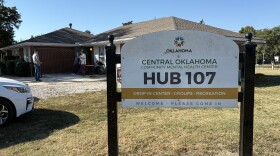The boulders appeared on Fourth Street as if by magic. But their placement near Tulsa’s Metrolink station is no accident; the rocks are intentionally unwelcoming, placed to deter those without homes from spending the night.
Oklahoma City installed inhospitable landscaping, too. Those boulders, placed in January, successfully thwarted impromptu encampments under the Oklahoma City Boulevard bridge.
“We really encourage people to not stay at this location because it is not a safe place for camping,” said Jamie Caves, strategy implementation manager for Oklahoma City’s Key to Home Partnership.
Officials for both cities said the boulders are to push people experiencing homelessness towards housing or other resources to combat homelessness, but experts claim those developments are not an effective way to address the problem. However, Oklahoma City is approaching the closure of the Boulevard bridge encampment with their housing-first projects, which seek to house people experiencing homelessness across the city.
The Boulevard bridge boulders are the only instance in which Key to Home in Oklahoma City has used the drastic measure of blocking an area, Caves said.
“We identified (under the bridge) for closure,” Caves said. “We wanted to help improve the safety of that area. It’s on a busier street that has a curve and people were sleeping right up against that road.”

Hostile Architecture
Hostile architecture is a design practice in public spaces that seeks to stop unwanted behavior.
The practice is a more modern and more explicit form of defensible space, said Wanda Liebermann, a professor and architectural and urban historian at the University of Oklahoma.
Defensible space, similar to hostile architecture, uses municipal architecture to prevent certain behaviors or people from being in public areas.
“It is a very old way of city leaders dealing with problems because they don’t see the problem as fellow human beings who are suffering,” Liebermann said.
When hostile architecture is established, homeless people tend to be driven away from the resources cities intend to drive them toward.
“What kind of message are we sending if we are promoting architecture that says, ‘You are not welcome here,’” said Meghan Mueller, chief executive officer of the Homeless Alliance in Oklahoma City. “It can absolutely be a barrier to access to resources.”
In Oklahoma City, nearly $44,000 was spent on the boulders underneath the Boulevard bridge to discourage further encampment. Tulsa’s boulder project, including landscaping products, was donated by a local quarry, a city spokesperson said.
Across the country, millions of dollars are being spent on hostile architecture, which could be used for affordable housing and emergency services, according to the National Coalition for the Homeless.
“It is much easier to tackle things like mental health or substance use disorders if you have at least the stability of having your basic physiological needs met,” Mueller said.
Housing-first projects and resources are being adopted by the Key to Home Partnership for people experiencing homelessness in Oklahoma City.
“First and foremost, we want to ensure we are not just moving people or kicking them out of the place that they are staying, so housing is a critical component to the work that we are doing,” Caves said.

Housing First
Housing-first projects prioritize permanent housing for people experiencing homelessness to improve their quality of life through shelter and resources like case management, healthcare and food.
Oklahoma City’s Encampment Rehousing Initiative finds encampments in the city and provides services to the people living in those areas to get housing. The project led to the Boulevard bridge encampment’s closure, and the 27 people living under the bridge being housed.
Teams from the project visit the encampments to provide resources to the people living there, such as ensuring they have the necessary requirements to move into housing, such as identifying documents, Caves said. If they do not, the teams will help them get the documents.
Of the 400 people who have been housed through the Key to Home Partnership, 95% of them have maintained their housing through the project.
“Eliminating harms or trying to help these people wasn’t served by putting rocks under the overpass,” Liebermann said. “It was served by actually reaching out to them and helping them find services and homes that actually fit their needs.”
Across the nation, several studies have shown that between 75% and 91% of people housed through similar programs remain housed, indicating the projects are successful, according to the National Alliance to End Homelessness.
“The unique thing about that initiative is that the housing is not theoretical,” Mueller said. “The housing opportunity is a mere weeks away.”
Oklahoma Watch, at oklahomawatch.org, is a nonprofit, nonpartisan news organization that covers public-policy issues facing the state.









